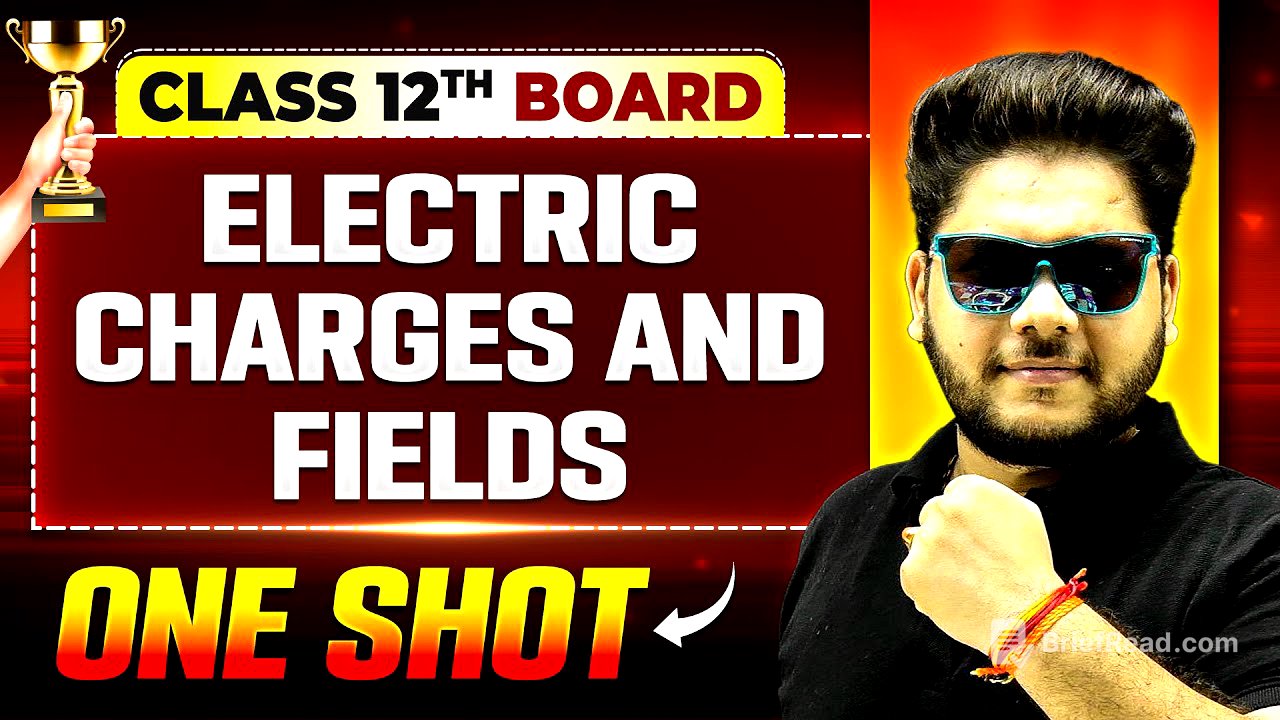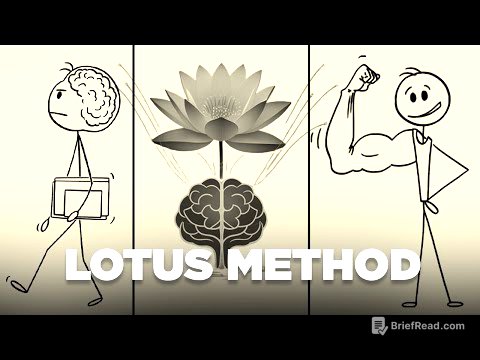TLDR;
This YouTube video by NCERT Wallah is the first class of the "Winners Series" for CBSE board exams, focusing on the chapter "Electric Charges and Fields." The lecture aims to provide a comprehensive understanding of the chapter, covering basic concepts, numerical problems, PYQs, and derivations. The instructor, Shailendra Pandey, emphasizes a zero-to-hero approach, ensuring students grasp every concept thoroughly.
- Electric charges and fields explained with experiments.
- Coulomb's law in vector form and its limitations.
- Electric field lines and their properties.
Introduction [0:00]
The session starts with a welcome and introduction to the Winners Series, designed to help students excel in their board exams. Shailendra Pandey assures students that the class will cover everything from basic concepts to numerical problems and previous year questions (PYQs). He promises a formula sheet and a surprise for the attendees.
Topics To Be Covered [3:30]
The class will cover detailed explanations of concepts, practice questions, and previous year questions (PYQs) from 2020 onwards. The aim is to make the Physics part of the board exam easier for students. A quick revision will be done at the end of the class.
Rules Of Class & Strategy [6:05]
The lecture duration is expected to be around 6 hours, including concepts from 11th grade. Students are advised to attend the class completely with full concentration, avoid chatting unrelated to the content, keep a pen and notebook for notes, and stay hydrated.
Strategy [8:55]
The strategy for the class is to maintain energy throughout the lecture and not give up, similar to the spirit of "Pushpa." Students are encouraged to stay until the end and provide feedback.
Electric Charge [11:22]
Electric charge is a fundamental property of matter. Substances are made of molecules, which are made of atoms. Atoms contain a nucleus with protons and neutrons, around which electrons revolve. Charge is an intrinsic property that creates electrical or magnetic effects. The symbol for charge is Q, and its SI unit is Coulomb (C), also known as Ampere-second. The CGS unit of charge is the electrostatic unit (ESU) or statcoulomb. 1 Coulomb is equal to 3 * 10^9 statcoulombs. Another CGS unit is the electromagnetic unit (EMU) or abcoulomb, where 1 Coulomb equals 1/10 abcoulomb. Practical units include Ampere-hour (1 Ampere-hour = 3600 Coulombs) and Faraday (1 Faraday = 96500 Coulombs).
Quantisation Of Charge [43:54]
Properties of charge include:
- Scalar quantity: Charge has no direction.
- Transferable: Charge can be transferred from one body to another.
- Associated with mass: Charge is always associated with mass. Fundamental particles like protons (positive charge, mass = 1.67 * 10^-27 kg), electrons (negative charge, mass = 9.1 * 10^-31 kg), and neutrons (no charge, mass ≈ proton mass) carry charge.
- Quantized: Charge is quantized, meaning it exists in discrete amounts. The total charge on any body is an integral multiple of the electronic charge (q = ne, where n is an integer).
- Conserved: The total amount of charge in any process remains constant.
- Invariant: The amount of charge does not change with speed.
- Accelerated charge radiates energy: Accelerated charges emit electromagnetic radiation.
- Like charges repel, unlike charges attract.
Quarks [59:29]
Protons and neutrons are made up of quarks. There are two types of quarks: up quarks (charge = +2/3 e) and down quarks (charge = -1/3 e). Quarks are never found alone; they are always combined with other quarks. A proton consists of two up quarks and one down quark, while a neutron consists of two down quarks and one up quark.
Methods Of Charging [1:02:52]
There are three methods of charging:
- Charging by rubbing (friction): When two objects are rubbed together, electrons are transferred from one object to another due to differences in their work functions.
- Charging by touching (conduction): When a charged object touches an uncharged object, charge is transferred, and both objects acquire the same type of charge.
- Charging by induction: When a charged object is brought near an uncharged object, it causes a separation of charge within the uncharged object.
Coulomb's Law [1:27:30]
Coulomb's Law states that the electrostatic force between two point charges is directly proportional to the product of the magnitudes of the charges and inversely proportional to the square of the distance between them. The formula is F = k * q1 * q2 / r^2, where k = 1 / (4πε0) = 9 * 10^9 Nm^2/C^2, and ε0 (permittivity of free space) = 8.85 * 10^-12 C^2/Nm^2. The force is a central force, acting along the line joining the centers of the two charges.
Vectors Revision [1:53:32]
A vector is represented by an arrow with magnitude and direction. A unit vector has a magnitude of one and indicates direction. The position vector of a point (x, y) is given by r = xi + yj, and its magnitude is √(x^2 + y^2). A unit vector is calculated as r̂ = r / |r|.
Coulomb's Law In Vector Form [2:04:58]
In vector form, Coulomb's Law is expressed as F12 = k * q1 * q2 * (r2 - r1) / |r2 - r1|^3, where F12 is the force on charge q2 due to q1, and r1 and r2 are the position vectors of q1 and q2, respectively. This form shows that Coulomb's Law follows Newton's Third Law, with equal and opposite forces between the charges.
Limitations Of Coulomb's Law [2:18:56]
Coulomb's Law has limitations:
- It is valid only for point charges.
- Charges must be at rest.
- The distance between charges should be greater than nuclear distances (10^-15 meters) to avoid the influence of strong nuclear forces.
The Superposition Principle [2:21:24]
The Superposition Principle states that the total force on a charge due to multiple charges is the vector sum of the forces due to each individual charge. The force between any two charges is independent of the presence or absence of other charges.
Electric Field [2:58:28]
The electric field is the region around a charge in which another charge experiences a force. The electric field intensity (E) is defined as the force per unit charge: E = F / q0, where q0 is a test charge. The unit of electric field is Newton per Coulomb (N/C). The electric field is a vector quantity, directed away from positive charges and towards negative charges.
Break 20 Minutes [3:16:42]
Break Time
Restart [3:36:40]
Restart after the break.
Electric Field Due To A Point Charge [3:39:02]
The electric field due to a point charge q at a distance r is given by E = k * q / r^2.
Concept Of Force In Electric Field [3:50:22]
A charge q placed in an electric field E experiences a force F = qE. The force on a positive charge is in the direction of the field, while the force on a negative charge is in the opposite direction.
Concept Of Motion [3:54:18]
There are two types of motion: uniform motion (constant speed, zero acceleration) and non-uniform motion (variable speed, non-zero acceleration). For uniform motion, speed = distance / time. For non-uniform motion with constant acceleration, the equations of motion (v = u + at, s = ut + 1/2 at^2, v^2 = u^2 + 2as) can be applied.
Electric Field Lines [4:12:04]
Electric field lines are imaginary lines that represent the electric field in a region. A tangent drawn at any point on a field line gives the direction of the electric field at that point.
Properties Of Electric Field Lines [4:15:12]
Properties of electric field lines:
- Electric field lines start from positive charges and end at negative charges.
- The tangent to a field line at any point gives the direction of the electric field at that point.
Electric Field Line Patterns [4:26:18]
Electric field lines are used to visualize and understand electric fields around different charge configurations.
Electric Dipole [4:27:39]
An electric dipole consists of two equal and opposite charges separated by a small distance.
Electric Field Due To Electric Dipole [4:29:38]
The electric field due to an electric dipole can be calculated at different points, such as along the axial line and the equatorial line.
Torque On Dipole In Electric Field [4:52:00]
A dipole placed in an electric field experiences a torque given by τ = pEsinθ, where p is the dipole moment, E is the electric field, and θ is the angle between p and E.
Continuous Charge Distributions [5:02:14]
Continuous charge distributions involve charge spread continuously over a line (linear charge density λ), surface (surface charge density σ), or volume (volume charge density ρ).
Motion Of Charge In Electric Field [5:10:36]
The motion of a charge in an electric field is governed by the force F = qE. This force causes acceleration, and the motion can be analyzed using kinematic equations.
Area Vector [5:22:28]
An area vector is a vector that represents an area element, with its magnitude equal to the area and its direction normal to the surface.
Electric Flux [5:27:06]
Electric flux (Φ) is a measure of the electric field passing through a given area. It is defined as Φ = E * A * cosθ, where E is the electric field, A is the area, and θ is the angle between E and the area vector.
Gauss Law [5:32:46]
Gauss's Law states that the total electric flux through a closed surface is equal to the total charge enclosed by the surface divided by ε0: ∮ E * dA = Qenclosed / ε0.
Electric Field Due To Line Charge [5:50:36]
Using Gauss's Law, the electric field due to an infinitely long line charge with linear charge density λ at a distance r is E = λ / (2πε0r).
Electric Field Due To Charged Sheet [6:03:54]
The electric field due to an infinite charged sheet with surface charge density σ is E = σ / (2ε0).
Electric Field Due To Thin Spherical Shell [6:17:06]
The electric field due to a thin spherical shell with charge Q and radius R is:
- E = 0 inside the shell (r < R)
- E = kQ / r^2 outside the shell (r > R)
PYQs [6:26:48]
Previous Year Questions
Summary Revision [7:01:20]
Quick summary revision of the whole class.
Formulas [7:06:10]
Formulas revision.
Homework [7:06:50]
Homework for students.
Thank you bachchhon!!❤❤ [7:07:39]
Thank you and goodbye.









